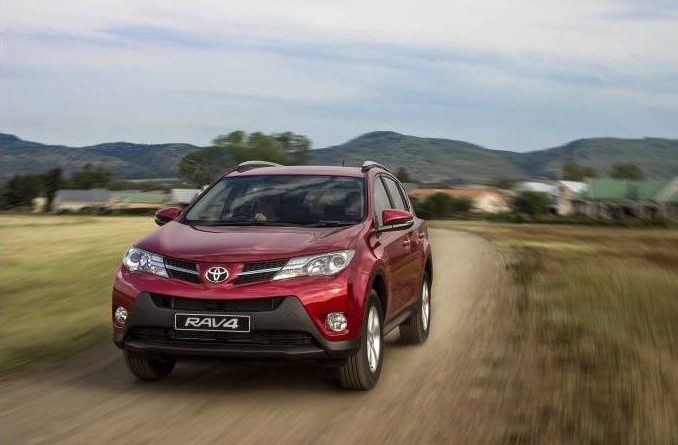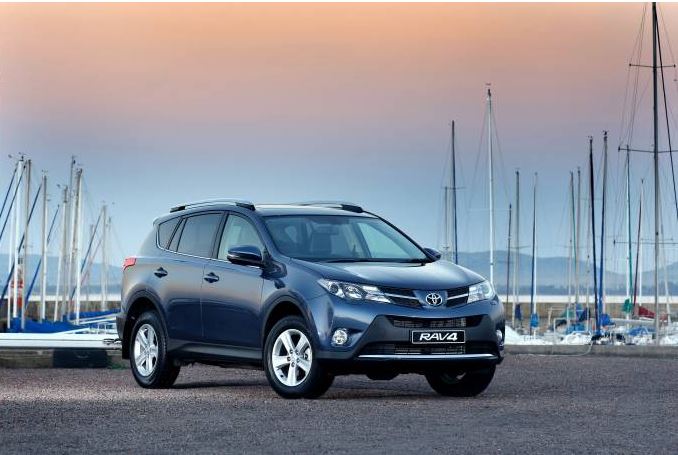RAV4 – The evolution of the original compact SUV

- Sophisticated bold design
- High-quality interior with improved ergonomics
- Three-engine line-up including a new 2.5 petrol engine
- All-new Integrated Dynamic Drive (IDD) system for AWD models
It seems you can’t navigate through the concrete jungle (or an organic one for that matter!) these days without coming across a compact SUV of some sorts. This shouldn’t come as a surprise – in 1994 Toyota kick-started the cross-over revolution with the very first RAV4.
Launched as a compact three-door model measuring just 3,69 metres in length, the original RAV was a radically different animal to what was then on offer in the form of traditional 4x4s. It featured a small engine mounted transversally within a monocoque bodyshell, and boasted an all-round independent suspension. The compact SUV market was born and the RAV success story continues… Available in over 150 countries, a recording-breaking three generations of RAV4 have sold more than 4.5 million units since launch. In South Africa we have more than 15 vehicles that can lay claim to the title ‘compact SUV’, but it’s worth remembering that it was Toyota that pioneered this segment.
Glenn Crompton, Vice President of Marketing, is upbeat about the newcomer: “Now in its fourth iteration, Toyota has put its superior experience to good use in the all-new 2013 RAV4. It has evolved both stylistically and dynamically; not only does it sport dramatic lines and a more mature interior, but it also offers a more engaging driving experience i.e. it blends all the best bits from its predecessors and adds a pleasing quality twist to proceedings while retaining the original model’s commitment to fun.”
Design
- Sophisticated, dynamic and bold exterior with signature Toyota design elements
- Improved aerodynamic performance for greater handling stability, a reduction in wind noise and enhanced fuel efficiency
205mm longer than its predecessor (now without the spare wheel carrier on the tailgate) at 4,570mm overall, the fourth generation of Toyota’s compact, versatile SUV showcases an all-new silhouette that emphasises its versatility, roominess and sporting character.
The new model has a 25mm lower roofline than the third generation RAV4; it’s 30mm wider and boasts a significant 100mm increase in wheelbase length, yet still delivers a class-leading turning circle of only 10.6 metres, ensuring good manoeuvrability and ease to drive in urban traffic.
The all-new muscular exterior stylishly interprets the signature elements of the new Toyota frontal design language:
- The stylish narrow grille central with chrome horizontal trim bar visually extending into the headlamp clusters;
- The large trapezoidal lower opening below the grille finished in black resin, flanked by integral foglamp housings (foglamps standard on 2.2 & 2.5);
- The now-familiar Keen Look (feline-eyed) headlamps incorporating LED Daytime Running Light (DRL) detailing.
In profile, the new RAV4 inherits the combination of space-efficient packaging, rising belt-line and distinctive silhouette that has hallmarked successive generations of Toyota’s compact SUV.
Above a more pronounced belt-line, blacked out B and C pillars emphasise the lengthened glasshouse and the vehicle’s interior roominess. ‘Below the belt’, the contrast of convex body surfacing and sharply concave treatment to the pronounced wheel arches and door sills provides added dynamism and strength to the new RAV4 silhouette.
To the rear, the cabin tapers strongly inwards, contrasting with the width of the lower body and creating muscular shoulders over the rear wheel arches to emphasise the vehicle’s, stable, planted stance. The increased strength of the belt-line and wheel arch shoulder at the rear of the car is further emphasised by a new rear combination lamp design which is generated by the proportions of the rear shoulder and flows around the corner of the vehicle to underscore the tailgate glazing.
Topped with an integral roof spoiler, the new tailgate itself is now top-hinged, and the rear gate mounted spare wheel has been removed to complete the new RAV4’s cleaner, more aerodynamically efficient design. In addition to the aesthetic advantages, the new design of the tailgate confers several other benefits including weight reduction and better space utilisation (the inner rear door is more concave in shape allowing for extra packing space).
The vehicle is equipped with a choice of 17” alloy wheels as standard and is available in a choice of 8 body colours, including four new hues in the model range: Greyish Blue Metallic, Eclipse Black Metallic, Crimson Metallic and Pearl White Metallic.

Improved Aerodynamic Performance
The new RAV4 has been styled using an ‘Air Management’ design approach for improved aerodynamics. This results in greater handling stability and enhanced fuel efficiency.
Front and rear aerocorners, and aerodynamically optimised wheel design and door mirrors minimise turbulence and stabilise airflow along the sides of the body. Based on advanced, Formula 1 technology, ‘Sakana’ fins located on the door mirror bases and rear combination lamps accelerate airflow along the body, enhancing vehicle stability and control.
The cabin has been tapered towards the rear, and the angles of the rear screen, roofline and its integral spoiler have been optimised to stabilise airflow over the upper body, further minimising turbulence and reducing drag.
Cabin quietness- and stability-enhancing air management measures to the underbody are equally comprehensive. They include front and rear wheel spats, an engine undercover, numerous floor undercovers, a fuel tank protector, rear suspension lower arm covers and a rear undercover.
In conjunction with the new RAV4’s reduced frontal projection, these aerodynamic improvements to several aspects of the bodyshell have lowered the vehicle’s coefficient of drag to just Cd 0.31.
Innovative, Higher Quality Interior Design
- Elegant, ergonomic interior styling featuring high quality materials, soft padding and Clear Blue instrument back-lighting
- Revised driving position for improved ergonomics, better forward visibility and a more engaging driving experience
The interior is where most drivers will find the bar significantly raised. Not only is the dash and center stack more modern and attractive to the touch, the interior cabin has more space.

The dynamic, bold architecture of the new dashboard features powerful upper and lower horizontal surfaces which emphasise the new cabin’s spacious, open atmosphere. Rooted in the transmission tunnel, a curved, metal-finish beam interrupts the horizontal surfaces to frame the driver’s instrument binnacle, steering wheel and footwell, reinforcing the new RAV4 interior’s more driver-focused credentials.
The clean, sophisticated elegance of the new design is further strengthened by the use of high quality materials, soft padding in many areas of occupant contact, crisp trim finishes and new colours throughout.
The leading edge of the upper dashboard horizontal surface is trimmed with a metallic finish, whilst the lower surface takes the form of a sweeping, soft padded panel (leather on the VX), matched by identical treatment to the upper door panels.
Silver trim accents highlight the driver’s instruments, air vents, centre console instruments and gear lever, and both door switch panels and the transmission tunnel are finished with simulated carbon-fibre panels.
All instrument and switchgear back-lighting is now a Clear Blue colour; a crisp, cool after-dark illumination which brings visual consistency to the new interior.
Focused, Ergonomic Driving Position
In keeping with the more cockpit-like driver’s environment, the driving position of the new RAV4 has been extensively revised for improved ergonomics, greater comfort, better forward visibility and a more engaging driving experience.
The driver’s seat hip point has been lowered by 5mm and downward seat height adjustment range has been increased by 15mm to 30mm. The steering wheel angle has been lowered by 2.3 degrees, and reach adjustment towards the driver increased by up to 38mm.
The increased seat height adjustment range allows not only to reach a lower and more engaging driving position, but also, at the driver’s choice, a higher driving position that improves the front visibility.
Combining greater comfort and holding performance with increased adjustability, the seat itself features a cushion contact area increase of 20mm, a cushion angle raised by 2 degrees with the side bolster positioned relatively higher for improved support, a seatback contact area increase of 30mm and taller, thicker side bolsters for improved lateral support.
The A pillars have been repositioned to a more outward location, increasing the driver’s forward field of vision by 3 degrees, and the cross-sectional width of the pillars themselves has been reduced by 8%.
Greater Space and Versatility
Though retaining the compact exterior dimensions essential to manoeuvrability, the new RAV4’s overall increase in length of 205mm (vs short wheel base without spare wheel carrier on the rear gate) and its increase in wheelbase length of 100mm equip it with significant additional interior space, bringing passenger roominess and loadspace up to a par with larger, D segment vehicles.
The front to rear seat couple distance has increased up to a best-in-class 970mm. This, allied to a new, thinner front seatback design, makes generous rear seat accommodation one of the outstanding attributes of the new model.
The 60:40 split folding rear seats themselves have been made more comfortable, benefitting from a rise in cushion surface angle of 2 degrees and revised side bolsters for improved support. The rear seats can be folded down almost flush with the loadspace floor without the need to remove any seat cushions or headrests.
The length of the loadspace has increased to 1,025mm, raising luggage capacity to a class-leading 547 litres.
The side-hung tailgate has been replaced by a top-hinged version, which is equipped with power operation on the VX model. At 645mm, the new tailgate opening boasts a remarkable low loadspace lip height, as well as a wide aperture of 1,158mm.
Powertrains
- Widest and most efficient engine line-up yet for the new RAV4, averaging an 11% reduction in CO2 emissions across the range
- Choice of front- or all-wheel drive, 6-speed manual, 6-speed automatic and CVT (Multidrive S) transmissions
In response to the continuing evolution of the compact SUV market and the demand for ever greater fuel and emissions efficiency, the new RAV4 offers customers a wider engine line-up than ever before. The new RAV4’s comprehensive range offers an unmatched balance between outstanding, front- and four-wheel drive performance and class-leading CO2 emissions in all petrol and diesel variants.
The powertrain line-up now comprises a 107kW 2.0 litre Valvematic petrol engine in two-wheel drive format mated to a choice of 6-speed manual or Multidrive S (Toyota’s highly-advanced Continuously Variable Transmission system) transmissions; a 110kW 2.2 litre D-4D diesel engine teamed up with a six-speed manual and the all-wheel drive capabilities of Toyota’s AWD System; and a 132kW 2.5 litre VVT-i petrol unit married to an all-new six-speed automatic transmission and AWD. Every engine in this new line-up benefits from reductions in CO2 emissions, averaging some 11% across the range.
| Engine | kW | WD | Trans. | CO2 (g/km) |
| 2.0 Valvematic | 107 / 6200 | 2WD | 6MT | 179 |
| 2.0 Valvematic | 107 / 6200 | 2WD | Multidrive S | 173 |
| 2.2 D-4D | 110 / 3600 | AWD | 6MT | 149 |
| 2.5 VVT-i | 132 / 6000 | AWD | 6AT | 198 |
2.0 Litre Valvematic Petrol Engine
The lightweight, compact, 4-cylinder 1,987 cc, 16 valve petrol engine develops 107kW at 6,200rpm. Maximum torque of 187 Nm is generated at 3,600rpm.
The unit is equipped with Valvematic – Toyota’s continuously variable intake valve lift mechanism, Dual VVT-i (Variable Valve Timing-intelligent), a variable length intake manifold system and a variable output oil pump. These highly efficient, lightweight and clean-emission technologies increase power output whilst reducing fuel consumption and emissions, and minimising noise and vibration. Fuel consumption and emissions have been reduced by some 6%.
The engine may be mated to a choice of 6-speed manual or CVT transmissions, and is available exclusively in two-wheel drive.
2.2 Litre D-4D Diesel Engine
The powerful, 4-cylinder 2,231 cc D-4D diesel engine features a variable nozzle turbocharger and a common-rail fuel injection system with piezo injectors. A TCCS (Toyota Computer Controlled System) incorporates a 32-bit processor for accurate, simultaneous control of fuel injection, injection timing, fuel pressure, glow relay and Exhaust Gas Recirculation (EGR).
The unit develops 110kW at 3,600rpm and maximum torque of 340Nm at between 2,000 and 2,800rpm. It comes standard with a six-speed manual transmission and all-wheel drive.
The adoption of scissor-driven, two-axle balance shafts and a resin cylinder head cover suppress engine vibration and reduce noise. The use of an aluminium cylinder block and the integration of the water and oil pumps within an aluminium chain cover offer significant weight reduction. And a roller rocker arm with built-in needle bearings significantly reduces friction to enhance fuel economy.
As a result, the fuel consumption and emissions of engines fitted with a manual transmission have reduced by over 7% to 5.6 ℓ/100km and 149 g/km respectively.
2.5 Litre VVT-i Engine
New to the RAV4 range is a new 2.5-litre dual-VVT-i*, four-cylinder engine in petrol AWD models. The Toyota 2AR-FE engine offers improved performance, driveability and fuel economy, lower emissions and improved NVH over the single VVT-i 2.4-litre engine (not previously available in SA) it supersedes. It is matched to a new advanced six-speed automatic transmission.
The Toyota 2AR-FE engine has an additional 7kW of power and 9Nm of torque compared with the superseded 2.4-litre petrol engine. The 2AR-FE engine has already been proven in Australia in the Toyota Camry. It has been recalibrated for RAV4, delivering 132kW of power at 6000rpm and 233Nm of torque at 4100rpm.
Fuel economy has been improved by 11.5 per cent for the automatic transmission model compared with the 2.4-litre petrol engine. Combined-cycle fuel economy for the new 2.5-litre RAV4 is 8.5 litres/100km.
The intake manifold design is lightweight, quiet and made from a multi-function resin that improves airflow. The design of the new intake port has been optimised through computer-aided engineering. It delivers high power output and improved fuel efficiency by ensuring high air flow and intake tumble flow.
Other engine features include low-tension piston rings, an offset crankshaft, three-stage variable output oil pump and roller rocker arms.
The use of roller rocker arms, rather than the previous system of valve lifters on a flat surface, results in better fuel economy due to significantly reduced friction between the cams and the sliding parts.
*Toyota uses the acronym VVT-i, with the ‘i’ standing for the intelligent way the system optimises valve timing across the engine operating range, providing maximum performance and fuel efficiency. The introduction of variable exhaust timing increases the amount of exhaust gas recirculation, for reduced emissions. The system reduces emissions even when the engine is cold (for example, at morning start-up).
TRANSMISSIONS
The new RAV4 offers customers a choice of 6-speed manual, 6-speed automatic and CVT transmissions.
6-speed Manual Transmissions
Two 6-speed manual transmissions are available – one for the 2.0 litre petrol engine, the other for the 2.2 litre D-4D diesel units. The latter is fitted with a triple cone synchroniser for 1st to 3rd gears, and a double cone synchroniser for 4th gear, reducing the shift force required to provide a smoother gear change.
6-speed Automatic Transmission
Available with the 2.5 litre petrol engine, the 6-speed Super ECT (Electronically Controlled Transaxle) automatic transmission is designed to combine high driving performance with low fuel consumption.
Combining steering wheel-mounted paddle shift override with Auto, Manual and Sport modes, the transmission features AI (Artificial Intelligence)-SHIFT Control, which automatically changes shift patterns in response to driving behaviour and road conditions.
It is also equipped with complete lock-up control in 2nd gear and above, enabling changes in engine output to be transmitted directly to the transaxle as with a manual gearbox and blipping downshift control for a smoother, more engaging driving experience in Manual and Sport modes.
CVT Transmission
Multidrive S is Toyota’s acclaimed Continuously Variable Transmission system as experienced on the new Verso. Delivering an infinite number of ratios through two cone-shaped pulleys and a high-strength steel belt, this new-age CVT system offers an incredibly smooth, seamless driving experience on the 2.0 petrol 2WD variant.
Because the transmission maintains the most efficient engine rpm at any given vehicle speed, it combines low cruising-speed noise with low CO2 emission and high fuel efficiency, yet can also maintain the ideal ratio to deliver peak engine power for maximum performance.
A ‘Sport’ button selects a more responsive, power-maximising ratio, delivering a more engaging driving experience. The transmission also features a sequential, manual 7-speed mode, with gear selection performed either by the gear shift lever or steering wheel-mounted paddle shifts. With the gearshift lever in the ‘D’ position, drivers can also use the paddle shifts to temporarily override the automatic mode.
Driving Performance
- Increased body rigidity for greater handling stability and improved steering response
- Retuned front and rear suspension and revised Electric Power Steering for enhanced steering feel and precision
- Integrated Dynamic Drive System – upgraded all-wheel drive system with Sport mode for enhanced on-road agility
Successive generations of RAV4 have established a reputation for their ride comfort, ease of driving, manoeuvrability and reassuring capabilities on challenging road surfaces. In conjunction with a new, more comfortable and focused driving position, the new RAV4 builds on these key attributes courtesy of retuned front and rear suspension systems, revised Electric Power Steering (EPS), and a newly developed Integrated Dynamic Drive System which is standard on all-wheel drive versions. In combination, these developments give the new RAV4 greater stability and agility on both wet and dry roads, offering customers a confidence-inspiring, more intuitive and engaging driving experience.
The new RAV4 is also available with both Down-hill Assist and Hill Start Assist Control. Fitted as standard on the 2.5 VX model, Down-hill Assist Control automatically regulates gear selection, engine speed and the individual wheel braking capabilities of the ABS system to help the driver maintain a constant speed during both on- and off-road descents.
Bodyshell Construction
The adoption of high and ultra-high tensile steel in the construction of the bodyshell allows for the use of thinner sheet with no loss of strength, thus reducing weight to enhance fuel efficiency. It has been used more widely throughout the new RAV4, including in such strategic locations as the reinforcement of the front cowl attached to the A pillars, the rear axle braces and the rear suspension coil spring upper supports.
Body rigidity has been improved through an increase in the number of spot welding points around both front and back door openings, enhancing yaw and steering response.
Retuned Front and Rear Suspension Systems
The new RAV4 shares the MacPherson strut front and lightweight trailing arm double wishbone rear suspension of its predecessor. However, both systems have been revised to optimise ride comfort whilst enhancing steering feel.
The spring rate of the front suspension has been revised. The increased rigidity of the front suspension member stabilizer bracket promotes a smoother steering feel when cornering. Contributing to both enhanced steering feel and improved ride comfort, friction in the inner structure of the shock absorber has been reduced, the characteristics of the stabiliser bushes have been optimised, and friction within them reduced through the use of a fluorine coating.
Similar measures have been adopted for the rear suspension system. The spring rate has been revised, and the diameter of the stabiliser bars increased to optimise the front/rear distribution of roll rigidity. The rear shock absorber and stabiliser bushes benefit from the same revisions as those made to the front suspension.
Revised Electric Power Steering
Both the installation and the ECU control of the Electric Power Steering (EPS) have been revised to combine a more comfortable driving position with improved steering precision and feel.
The steering column has been tilted downward by 1 degree, and the installation angle of the new steering wheel has been changed from 27.6 to 25.3 degrees, moving it closer to the driver.
The Electronic Control Unit (ECU) and EPS have been integrated to reduce vehicle weight, and the adoption of a resin-coat intermediate shaft and revised software compliance has improved steering precision and feel.
Integrated Dynamic Drive System
The new RAV4 is available with either front-wheel drive (2.0) or the Integrated Dynamic Drive System (2.2 & 2.5), an upgraded version of Toyota’s advanced all-wheel drive technology featuring a new Sport mode.
The Integrated Dynamic Drive System is a sophisticated, high-speed interactive management system which coordinates control of the RAV4’s Dynamic Torque Control AWD, Vehicle Stability Control (VSC) and Electric Power Steering (EPS) systems to enhance the compact SUV’s performance, handling and safety.
Using information from various sensors (speed, steering angle and yaw rate), the Dynamic Torque Control AWD system continuously controls the torque transfer between the front and rear wheels via an electromagnetically controlled coupling positioned in front of the rear differential. Front to rear torque distribution can vary from 100:0 to 50:50, with front-wheel drive (100:0) automatically engaged under normal driving conditions to improve fuel consumption.
In normal mode -when neither Sport mode nor Lock mode are activated- torque transfer to the rear wheels now takes place not only when the front wheels are beginning to slip on slippery surfaces (as in the third generation RAV4) but also when the system detects understeer during cornering on road. As a result, the overall agility and driving performance of the vehicle is enhanced during both on- and off-road driving.
When the new Sport mode is selected, torque transfer to the rear wheels begins even before understeer develops. From the moment the steering wheel is turned, the Dynamic Torque Control AWD System operates a newly developed pre-torque control, automatically introducing a 90:10 front/rear torque distribution to help cornering force by transferring traction torque to rear. If actual understeer develops, torque transfer to the rear wheels is automatically increased by up to 50% through a new yaw rate feedback control, to provide front tyres with improved lateral grip. As well as activating the ‘Dynamic’ behaviour of the system’s front to rear torque transfer, the new Sport mode also decreases the RAV4’s power steering assistance by 20%, sharpens throttle response and offers higher revs for a more dynamic, sporting driving experience.
For off-road driving, the system incorporates an AWD Lock button. This allows drivers to lock torque distribution in a fixed, 50:50 ratio at speeds up to 40km/h. Above this speed, the system automatically reverts to Normal mode.
From Integrated Active Drive System to Integrated Dynamic Drive System
The third generation RAV4 used Integrated Active Drive System, in which torque control was managed by an Active Torque Control 4WD system. The new RAV4 now uses a Dynamic Torque Control AWD System.
Compared to the third generation car, the new RAV4 keeps the following functions:– Starting Control: traction performance when starting on snowy or muddy roads is ensured by increasing the rear torque distribution up to 50%. At speeds above 25km/h, the driving control switches to normal driving control.
– Normal driving control: on highways or urban roads, the rear torque distribution is reduced to 0% to enhance fuel efficiency. When detecting slippery roads in which wheel skidding occurs, torque control is immediately activated to ensure driving stability.
– VSC co-operative control: When the front wheels skid and the vehicle runs outside the driver’s intended path, EPS assists for the turning direction (by creating torque in the steering wheel), and torque is distributed to the rear wheels.
– Braking control: AWD is cancelled to enhance the effects of ABS a and the VSC System.
– Lock mode control: when the driver pushes the LOCK mode switch. 50% of torque is transmitted to each axle to enhance off-road performance in situations such as when the vehicle is stuck.
The new function added on top of these 5 control modes is:– Cornering control: Yaw rate feedback control is used to adapt rear wheel torque to assist cornering performance by generating optimal drive force distribution and balancing the load between front/rear wheels. With Sport mode activated, from the first steering input, 10% of the torque is directed to the rear wheels at the start of the corner which can increase to a maximum of 50% during cornering to ensure driving stability and a fun to drive experience. Thanks to cornering control, the Integrated Dynamic Drive system helps the driver to maintain his intended trajectory and, at the end, have a more enjoyable driving experience.
Comfort
- Substantial NVH reduction measures through new Engine Bay Barrier design concept for better cabin quietness
- Two model grades and a comprehensive list of standard equipment
Low NVH measures
The new RAV4 incorporates a substantial range of measures to suppress the transmission of noise and vibration into the cabin, resulting in increased quietness for all occupants. Under a new engine bay barrier design concept, extensive improvements have been made to the sound proofing qualities of the dashboard, dashboard inner and outer silencers, the cowl insulator and the bonnet insulator, reducing the transmission of engine noise to the cabin.
Additional sound-proofing materials have been optimally positioned throughout the new RAV4. They include foamed material introduced within cabin pillars, as well as the door sill and head sections, to minimise the transmission of noise through the bodyshell. Both a spray-application underfloor damping material and front and rear fender liners reduce the transmission of noise.
Noise has been reduced by the adoption of an acoustic windscreen which features an additional layer of acoustic film to reduce noise transmission. The aerodynamic shaping of the door mirrors further reduces wind noise.
Various measures have been also been adopted to reduce the transmission of vibration to the cabin. Body panels that generate noise have been identified and fitted with vibration damping materials, front and rear suspension mounting points have been stiffened, and the shape of the steering knuckles optimised to improve the vibration characteristics of the front suspension and reduce road noise.
Two Trim Levels
The new RAV4’s trim levels (GX and VX) offer a generous sliding scale of kit. GX models are anything but spartan thanks to exterior features such as standard roof rails, 17” alloys, and Daytime Running Lights (DRL). The only external differentiator between the 2.0-litre models and the 2.2 D-4D is the addition of integrated foglamps for the latter. Step up to the flagship VX and you gain a chrome insert in the front bumper, front and rear mud flaps, power retractable side mirrors, a moon roof with tilt and slide function, and High Intensity Discharge (HID) headlamps with cleaning system.
Move indoors and the high spec count continues. Standard fare on offer on the GX models includes power windows, remote central locking, manual climate control, touch-screen Multi Information Display incorporating a stereo system, steering controls, retractable tonneau cover with net barrier and rear Park Distance Control (PDC) to name just a few of the features.
The VX grade tops up with full leather upholstery, electrically adjustable driver’s seat with lumbar support, front seat heaters, automatic dual-zone climate control, a reversing camera display, a powered tailgate with memory function, cruise control and a keyless entry system (Smart Entry).
Safety
The new RAV4 builds on the high standards of occupant safety and pedestrian impact protection evolved over three generations of the compact Toyota SUV, with even higher levels of active and passive safety. With an impact absorbing, multi-load-path body construction designed to help provide occupant protection, the new RAV4 has been engineered to achieve a 5-Star rating in the 2013 Euro NCAP crash test programme.
The new Toyota SUV is equipped with a new, whiplash injury reducing seat design, and seven airbags are fitted as standard, including a driver’s knee airbag and twin-chamber front seat side airbags.
Active safety systems include ABS with EBD, BA, VSC (Vehicle Stability Control) and TRC (Traction Control), and all-wheel drive models are equipped, as standard, with VSC+, which integrates VSC and the vehicle’s Electric Power Steering (EPS)
Accessories
A high percentage of RAV4 customers appreciate the breadth of customisation possibilities currently offered by Toyota’s compact SUV. Sold through the official dealer network, a complete range of accessories will be available from the launch of the new car.
These range from floor mats and trunk liners to front guards (incorporating an integrated silver underguard) and detachable towbars. Integrated Satellite Navigation is available as a dealer-fit option (involves software and hardware upgrades) for under R9 000.
Pricing
– RAV4 2.0 2WD GX 6-spd manual R279 900 (incl. VAT)
– RAV4 2.0 2WD GX CVT R289 900 (incl. VAT)
– RAV4 2.2 D-4D AWD GX 6-spd manual R359 900 (incl. VAT)
– RAV4 2.5 AWD VX 6-spd auto R399 900 (incl. VAT)
The new RAV4 benefits from a three year/100,000km warranty and comes with a standard five-year/ 90 000 km service plan. The new models are also supported by the ToyotaCare Roadside Assistance Programme which entitles customers to 24-hour roadside assistance, ensuring ultimate peace-of-mind motoring.





